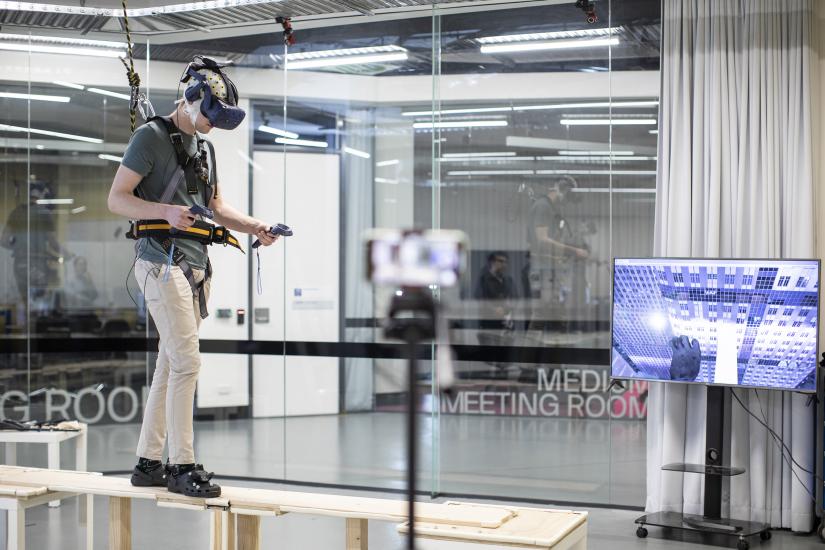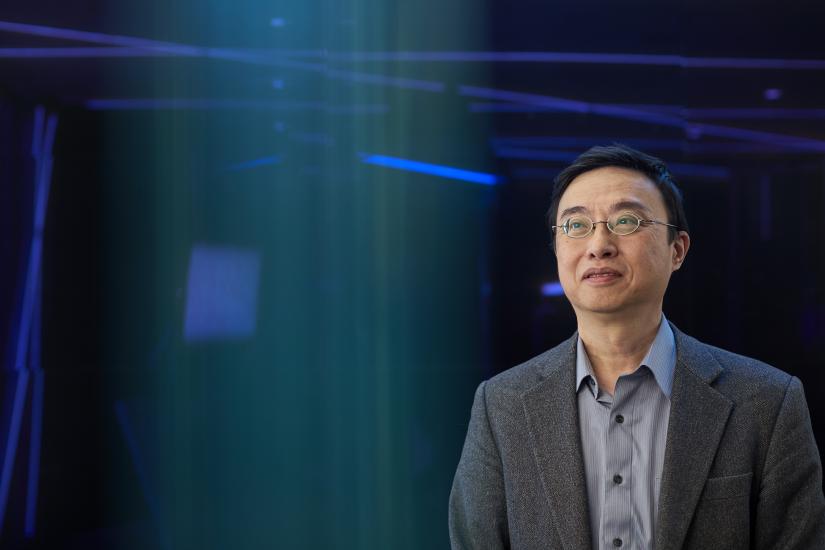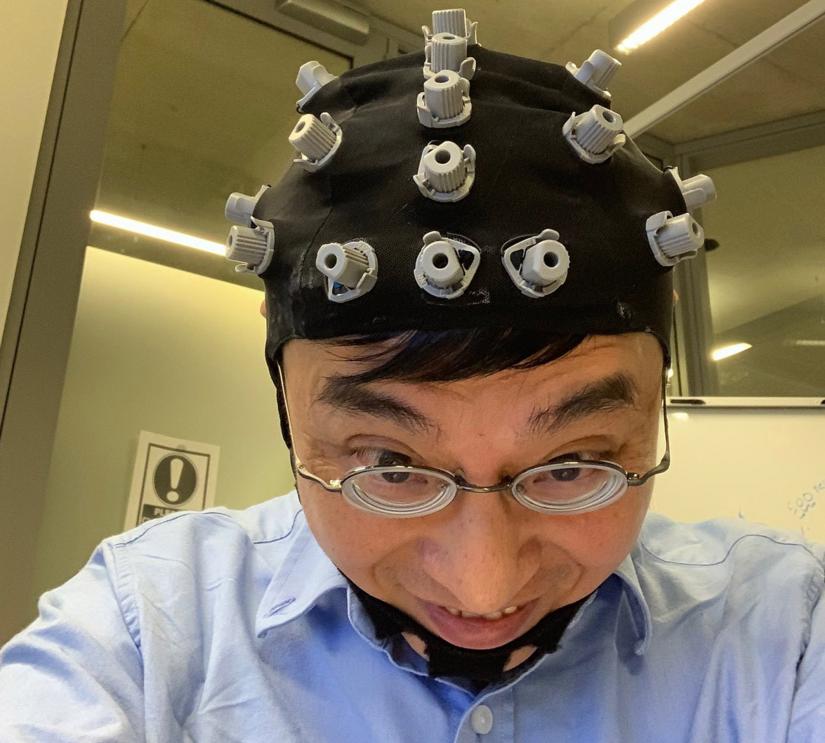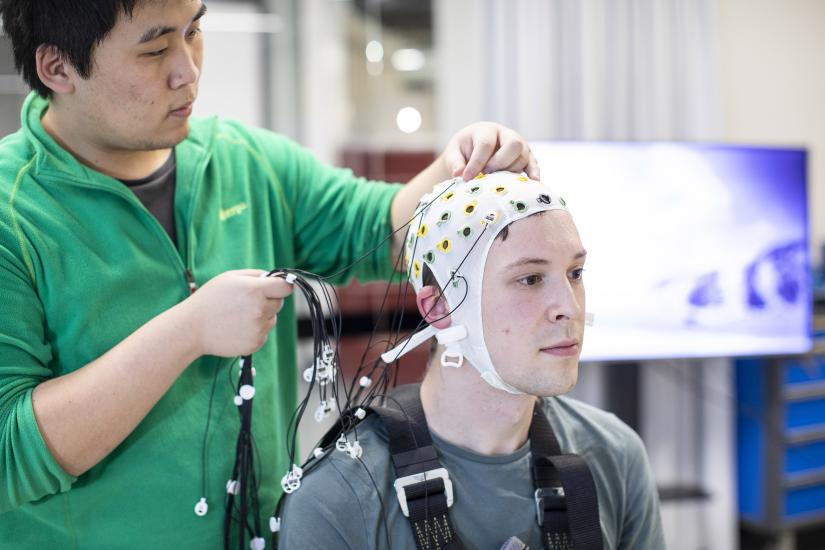The era of human-machine cooperation is coming, when industry will synergise the intelligence of the brain and the power of advanced machine learning. Professor CT Lin has started a Discovery project to develop models and algorithms for intuitive physical collaboration between humans and robots.

Professor CT Lin has used virtual reality technology and physical platforms to gain a better understand of human physiological stress and its effect on cognitive performance. Photo by Anna Zhu
The era of human-machine cooperation
Professor CT Lin works at the forefront of research into brain-computer interface. He is an expert in computational intelligence, machine learning, fuzzy neural networks and cognitive neuro-engineering, as well as robotics and human-machine teaming.
What is the focus of your Discovery project?
Advancing the development of intelligent assistive robots will be key to Industry 5.0, the era of human-machine cooperation, which will be upon us in the next five years or so. These might be heavy-duty robots able to work in construction, manufacturing, mining or health. Highly complex cooperation between human and robot would allow the robot to understand the human’s intention and do a better job on laborious tasks in complex, unstructured environments.
My project is designed to discover new knowledge of cognitive conflict and develop models and algorithms that enable intuitive physical human-robot collaboration. My research will help to develop robots that can collaborate with humans in industrial applications where humans are still needed to do physically intensive tasks, spend long periods of time resisting large forces, have to adopt awkward body postures, and work in dusty and noisy environments.
There will be economic benefits for Australia in improved productivity, reduced cost of injuries, support for the nation’s skills base and new business opportunities.

Professor CT Lin has spent the past three decades on research to enhance interactions and cooperation between humans and robots. Photo by Toby Burrows
What has been your career pathway to this point?
About 30 years ago, I started working on the synergy of machine intelligence and human intelligence, with the career goal of “augmented human intelligence”. I brought the high-level human-like thinking and reasoning of fuzzy logic into artificial neural networks, and brought the low-level machine-learning capability of artificial neural networks into fuzzy logic. The result was my invention in 1992 of the fuzzy neural networks computational model.
About 20 years ago, I started my research in natural cognition because the knowledge of brain dynamics of people performing ordinary tasks in natural body positions and real-world situations could benefit the enhancement of machine intelligence directly.
I started to integrate natural cognition with artificial intelligence, computational intelligence and, in particular, fuzzy neural networks about 10 years ago, and developed various kinds of brain-computer interface systems. My Discovery project will synergise the brain intelligence and power of advanced machine learning to enhance the interactions and cooperation between humans and robots.
The era of human-machine cooperation will bring economic benefits for Australia in improved productivity, reduced cost of injuries, support for the nation’s skills base and new business opportunities.
Professor CT Lin
Have mentors and collaborators played an important role in your career?
I have had several excellent mentors, including my PhD supervisor at Purdue University in the US, Professor George Lee, who is a pioneer in robotics dynamics and control. Professor Lotfi Zadeh at University of California, Berkeley, internationally recognised as the father of fuzzy logic, guided me in the foundations of fuzzy logic and we have maintained a close collaboration since my first visit to his laboratory in 2002. My first exposure to computational neural science came through Professor Terry Sejnowski when I visited his research laboratory at University of California, San Diego in 2004. And there’s my Discovery project collaborator, Professor Dikai Liu – we talk every week about our challenge to increase and enhance the interactions between human and robot.
What has been your most rewarding achievement?
Among more than 300 research projects I have executed, the most exciting one for me is the Cognition and Neuroergonomics project for the Collaborative Technology Alliance, funded by US Army Research Lab from 2009 to 2020. It is the first time the US Army Research Lab has supported a foreign organisation on a large scale.
This project consists of three research topics: neurocognition, neurocomputation, and neurotechnology. I led the topic of neurotechnology, studying the effects of vehicle motion and cognitive fatigue, and wearable EEG devices development and testing.

Professor CT Lin wears a wireless EEG device for a brain-robot interface experiment.
What is your family background? Where did you grow up?
I was born and grew up in Tainan, the most historic city of Taiwan, where I finished my elementary and high schools studies. I did my undergraduate study at National Chiao-Tung University in Hsinchu, the so-called Silicon Valley of Taiwan. I got my Master and PhD degrees from Purdue University in the United States. My wife was a lawyer and judge in Taiwan before we moved to Sydney in 2016. We have three boys; two are at university, studying physics, electrical engineering and computer science, and the youngest is at high school.
What was your first job?
My very first job was tutoring high school students in maths and physics when I was a college boy. This experience may have planted a seed for my career as a teacher.

Preparing to measure the effect of physiological stress on cognitive performance. Photo by Anna Zhu
What advice would you give your undergraduate self?
The world changes rapidly, especially in technology. My advice to any undergraduate student would be to prepare as best you can on solid fundamental scientific knowledge. It is essential to face the changing world in the years after graduation and throughout your career.
How do you maintain a healthy work/life balance?
I think keeping a calm and peaceful mind is essential to healthy work and life balance. Meditation, gardening and house cleanliness are some major activities I usually take to keep a calm mind.
Professor Chin-Teng (CT) Lin is director of the Computational Intelligence and Brain Computer Interface Centre (CIBCI) and co-director of the Centre for Artificial Intelligence, both in the UTS Faculty of Engineering and IT.

